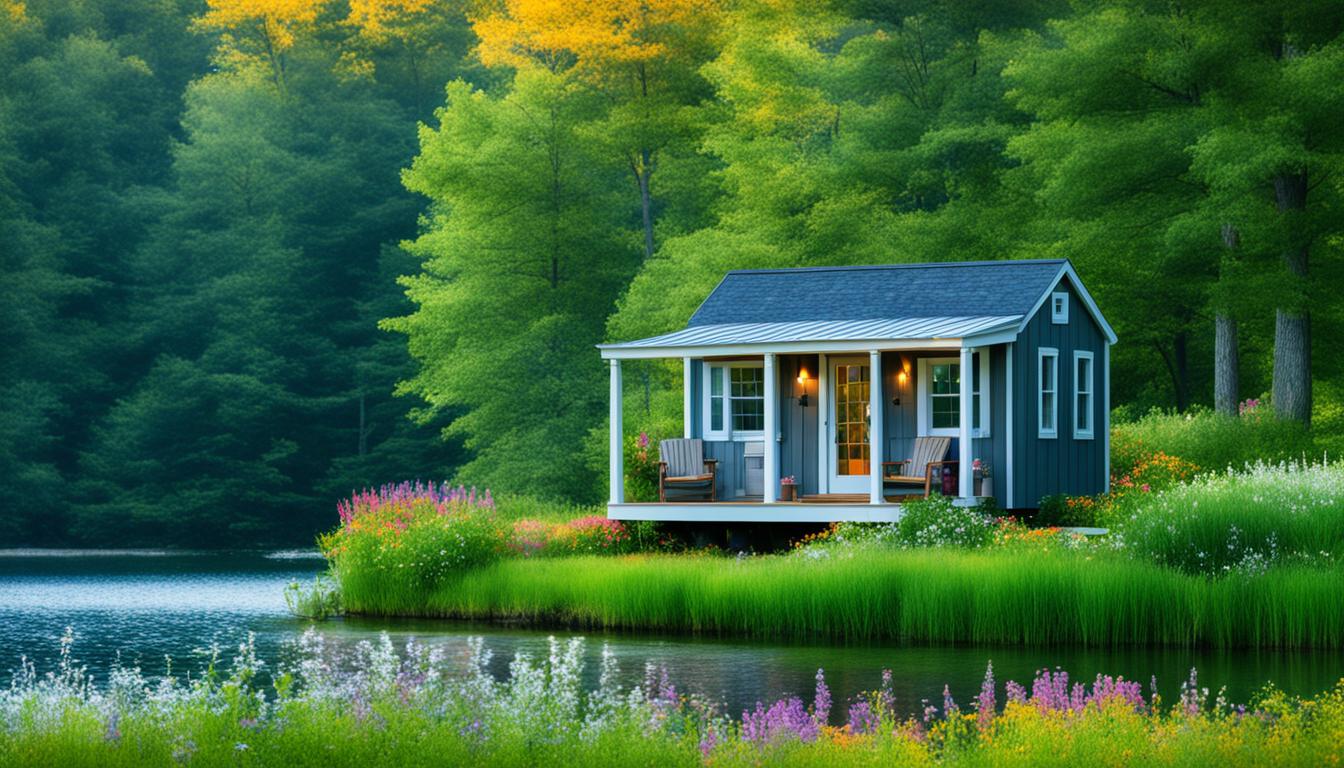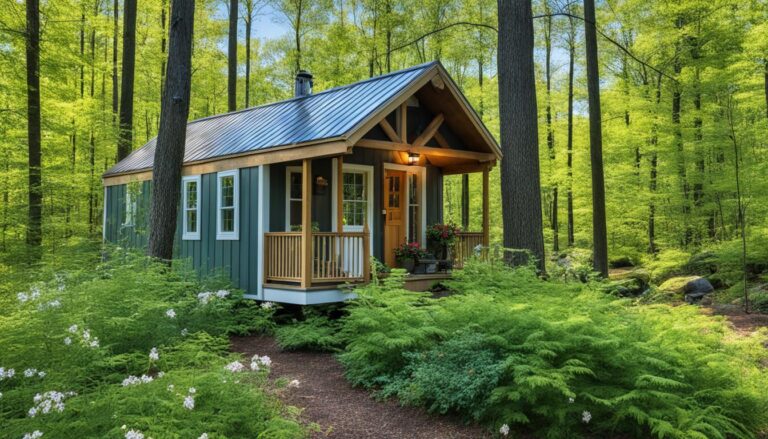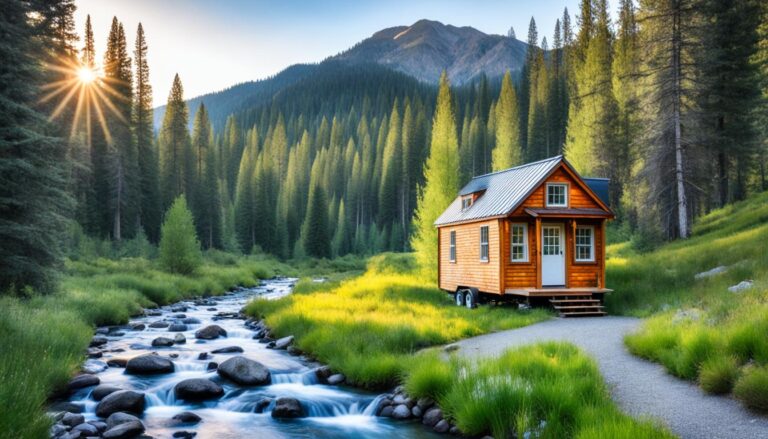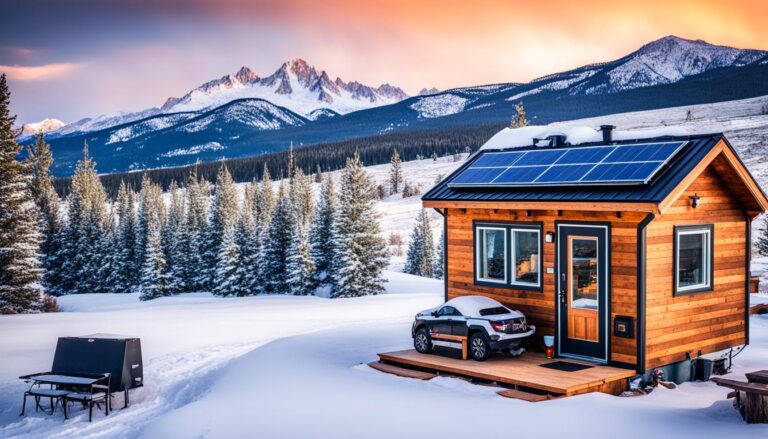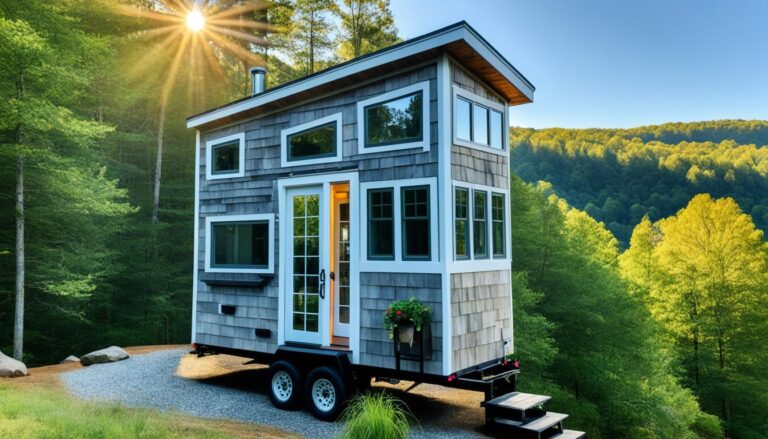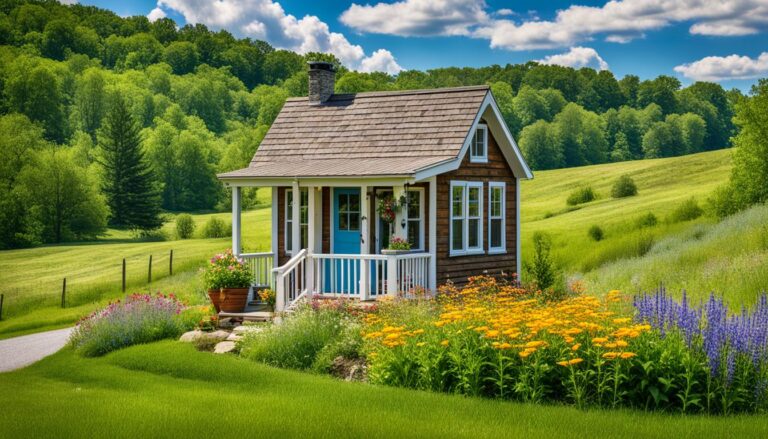Find Your Tiny House Spot in Maryland
Are you ready to join the tiny house movement and build your own cozy retreat in Maryland? Before you begin, it’s crucial to understand the rules and regulations that govern these unique dwellings. From choosing the right location to complying with building codes, there’s a lot to consider. But fear not, we’ve got you covered!
In this comprehensive guide, we’ll walk you through the process of finding the perfect spot for your tiny house in Maryland. We’ll explore the different regulations in various counties, highlight tiny house-friendly locations, and provide insights into building codes and placement options. So, if you’re eager to embark on a minimalist lifestyle, keep reading to discover all you need to know about tiny house living in the Old Line State.
Key Takeaways:
- Understanding Maryland’s tiny house regulations is essential before starting your project.
- Different counties have different laws and ordinances regarding tiny houses, so thorough research is necessary.
- Montgomery County and Garrett County are known for their tiny house-friendly regulations.
- Maryland follows the International Residential Code (IRC) and uses Appendix Q for tiny house construction.
- Placement options for tiny houses in Maryland include RV parks, tiny house communities, and private properties.
Understanding Maryland’s Tiny House Regulations
The laws and approval of small dwellings in Maryland vary from county to county. While some counties have not addressed the matter, others have implemented special ordinances that permit tiny houses. It is crucial to note that small dwellings exist in a gray zone in the state of Maryland, as there are no explicit laws governing them. Therefore, understanding the laws and guidelines surrounding Maryland’s small homes, including zoning restrictions, construction norms, and legal matters, is essential.
Tiny House-Friendly Counties in Maryland
When it comes to finding the perfect location to build your tiny house in Maryland, there are a few counties that stand out as being particularly friendly and accommodating. These counties have regulations in place that make it easier for tiny house enthusiasts to pursue their dream of a minimalist, sustainable lifestyle. Let’s explore some of the top choices:
Montgomery County
Montgomery County is a great option for those looking to build a tiny house in Maryland. The county’s residential zoning ordinance permits the construction of tiny houses and linked units. Not only that, but the council has also taken steps to amend the zoning regulations to create more affordable housing options for pensioners and low-income citizens. This makes Montgomery County an attractive choice for tiny house builders and residents.
Garrett County
Another county that is considered a haven for tiny house enthusiasts is Garrett County. Located in western Maryland, Garrett County offers a more relaxed approach to tiny house regulations. This makes it an ideal place for those looking to live off the grid or embrace a simpler way of life. With its scenic landscapes and relaxed laws for tiny dwellings, Garrett County is definitely worth considering as a place to build your tiny house in Maryland.
These are just a couple of examples of the tiny house-friendly counties in Maryland. However, it’s important to note that regulations and conditions may differ from county to county, so it’s always wise to do thorough research and consult with local authorities when planning your tiny house project in Maryland. By understanding the specific regulations, you can ensure a smooth and successful journey towards your tiny house dreams.
Maryland’s Building Codes and Requirements for Tiny Houses
When it comes to building a tiny house in Maryland, it’s crucial to understand the specific requirements and regulations in place. Maryland complies with the International Residential Code (IRC) and utilizes Appendix Q of the 2018 IRC, which specifically addresses rules for small dwellings under 400 square feet. These regulations establish guidelines for construction, safety, and habitability.
The building code in Maryland requires new residences to have a minimum total floor area of 320 square feet, with individual usable rooms needing a minimum size of 120 square feet. These size limitations ensure that tiny houses meet the minimum standards for comfortable living.
Adhering to building codes is essential not only for your safety and well-being but also to ensure compliance with local laws. By following these regulations, you can enjoy the benefits of tiny house living while maintaining the necessary standards set by the state.
Key Requirements for Tiny House Construction in Maryland:
- Minimum Floor Area: Maryland requires a minimum total floor area of 320 square feet for new residences.
- Usable Room Size: Each individual usable room in a tiny house must have a minimum size of 120 square feet.
- Safety Standards: Compliance with safety codes, such as proper electrical wiring, plumbing, and structural stability, is crucial to ensure the well-being of the occupants.
- Building Permits: Before commencing construction, it is essential to obtain the necessary building permits from the respective county or local jurisdiction.
- Accessible Design: Maryland encourages the inclusion of accessibility features in new residential construction, ensuring that tiny houses accommodate individuals with disabilities.
By familiarizing yourself with the building codes and requirements for tiny houses in Maryland, you can successfully navigate the process of constructing and legally residing in a tiny home.
Placement Options for Tiny Houses in Maryland
Tiny homes offer flexibility in terms of placement in Maryland. Whether you prefer the convenience of an existing community or the freedom of private property, there are various options available to suit your needs.
Tiny House Communities
Tiny house communities provide a supportive and like-minded community for tiny house enthusiasts. These communities often offer shared amenities and a sense of belonging. In Maryland, notable examples include:
- Liberty Village: Located near Frederick, Maryland, Liberty Village is a cohousing community built on 8 acres of land. With 18 tiny dwellings, it offers a close-knit and sustainable residential option.
- Blue Moon Rising: Situated in McHenry, Maryland, Blue Moon Rising is an eco-friendly tiny house community that prioritizes sustainability and environmental stewardship.
RV parks, National Parks, and Campgrounds
RV parks, national parks, and campgrounds can be excellent options for tiny house placement in Maryland. These locations often provide amenities such as water, electricity, and waste disposal. Keep in mind that each park or campground may have specific regulations regarding tiny house placement and duration of stay, so it’s essential to check with the individual park beforehand.
Private Properties
Private properties offer flexibility and the possibility of customization for tiny house owners. If you have access to land or are considering purchasing property, placement of your tiny house could be an option worth exploring. However, it’s essential to ensure compliance with local zoning laws and any applicable regulations.
When choosing a placement option for your tiny house in Maryland, it’s crucial to consider factors such as accessibility to amenities, proximity to desired locations, and personal preferences. Conduct thorough research and consult with local authorities to ensure compliance and a seamless living experience.
Notable Tiny House Communities in Maryland
Maryland is home to some remarkable tiny house communities. These communities provide unique opportunities for individuals looking to embrace a simpler lifestyle and reduce their carbon footprint.
One notable tiny house community in Maryland is Liberty Village. Located near Frederick, Maryland, this cohousing community features 18 charming tiny dwellings spread across 8 acres of land. Liberty Village offers a tight-knit community atmosphere where residents can enjoy the benefits of shared spaces and resources.
Another exceptional tiny house community worth mentioning is Blue Moon Rising. Situated in McHenry, Maryland, Blue Moon Rising is an environmentally-conscious small home community. With a focus on sustainability, this community offers residents the chance to live in beautifully crafted tiny homes while minimizing their impact on the environment.
Looking to explore more about tiny house communities in Maryland? Check out this Architectural Digest article for a glimpse into a 300-acre Maryland compound with a focus on tiny homes.

Joining a tiny house community in Maryland can provide an incredible sense of belonging and a chance to live sustainably. These communities offer a supportive environment where like-minded individuals can share their passion for small living and create lasting connections.
Buying a Tiny House in Maryland
If you’re looking to buy a tiny house in Maryland, you’re in luck! There are options available for those ready to embrace the tiny house lifestyle. One notable provider is Great Lakes Tiny Homes, offering a selection of tiny home designs that can be delivered nationwide.
Working with a certified builder like Great Lakes Tiny Homes ensures that your tiny house meets all the necessary regulations and standards required in Maryland. From design to construction, their expertise will guide you through the process, making your dream of owning a tiny house a reality.
By purchasing a tiny house from a reputable builder, you can have peace of mind knowing that your home is well-built and compliant with all applicable regulations. Whether you’re planning to downsize, have a vacation home, or explore sustainable living options, a certified builder like Great Lakes Tiny Homes can assist you in finding the perfect tiny house for your needs.
Did you know that purchasing a tiny house in Maryland allows you to join a growing community of like-minded individuals seeking simplicity and sustainability? With the expertise of a certified builder, you can embark on your tiny house journey with confidence.
Legal Considerations
It’s important to note that purchasing a tiny house is just the first step. Once you have your tiny house, you’ll need to consider the legal aspects of living in it. As mentioned in earlier sections, Maryland’s tiny house regulations vary by county. Familiarize yourself with these regulations to ensure a smooth transition to tiny house living.
Additionally, staying updated on the latest developments regarding tiny house legality is crucial. Anne Arundel County, for example, is currently considering making tiny houses legal within its jurisdiction. This provides an exciting opportunity for prospective tiny house owners in the area. For more information on this topic, click here.
Owning a tiny house in Maryland is an excellent way to embrace an alternative lifestyle and reduce your ecological footprint. With the available options for purchasing a tiny house and the support of certified builders, you can embark on your tiny house journey confidently and enjoy the benefits of living in a compact and sustainable home.
Living in a Tiny House in Maryland
Living in a tiny house permanently in Maryland offers a unique and sustainable lifestyle. Whether you’re looking for a minimalist living experience or a way to reduce your environmental impact, tiny house living can be a practical choice. However, it’s essential to ensure compliance with local laws and regulations to make your tiny house experience seamless and hassle-free.
In Maryland, each county may have different regulations regarding tiny houses. It’s crucial to research and consult with local authorities to understand the specific guidelines in your area. By familiarizing yourself with the regulations, you can avoid any potential conflicts and enjoy your tiny house as a permanent residence in Maryland.
One county in Maryland that has embraced tiny houses is Montgomery County. Known for its progressive zoning ordinances, Montgomery County permits the construction of tiny houses and linked units. This county actively seeks to provide more affordable housing options for pensioners and low-income individuals. To learn more about Montgomery County’s efforts, you can visit their official website.
Additionally, Garrett County is another notable location for tiny house living. With more relaxed laws for tiny dwellings, this county offers a great opportunity for those looking to live off the grid and embrace a simpler lifestyle.
When living in a tiny house in Maryland, it’s important to remember that size limitations and building codes may still apply. The state follows the International Residential Code (IRC) and uses Appendix Q of the 2018 IRC, which addresses rules for small dwellings under 400 square feet. Maryland’s building code requires new residences to have a minimum of 320 square feet, with usable rooms requiring a size of at least 120 square feet.
If you’re interested in joining a community of like-minded individuals, there are also tiny house communities in Maryland. Two notable examples are Liberty Village and Blue Moon Rising. Liberty Village, located near Frederick, Maryland, is a cohousing community with 18 tiny dwellings built on 8 acres of land. Blue Moon Rising in McHenry, Maryland, offers an eco-friendly and sustainable residential option for those seeking a unique living experience.
Living in a tiny house in Maryland has its advantages. It can be an affordable housing option, allowing you to live in a smaller space with reduced expenses. Moreover, tiny houses have a minimal environmental impact due to their smaller footprint. Additionally, embracing a tiny house lifestyle often means simplifying your possessions and focusing on what truly matters to you.
Considerations for Maryland tiny house living include ensuring you have adequate square footage requirements in compliance with local regulations, connecting utilities to your tiny house, and finding suitable parking arrangements. By proactively addressing these considerations and understanding the nuances of tiny house living in Maryland, you can embark on a rewarding and fulfilling journey in your tiny home.
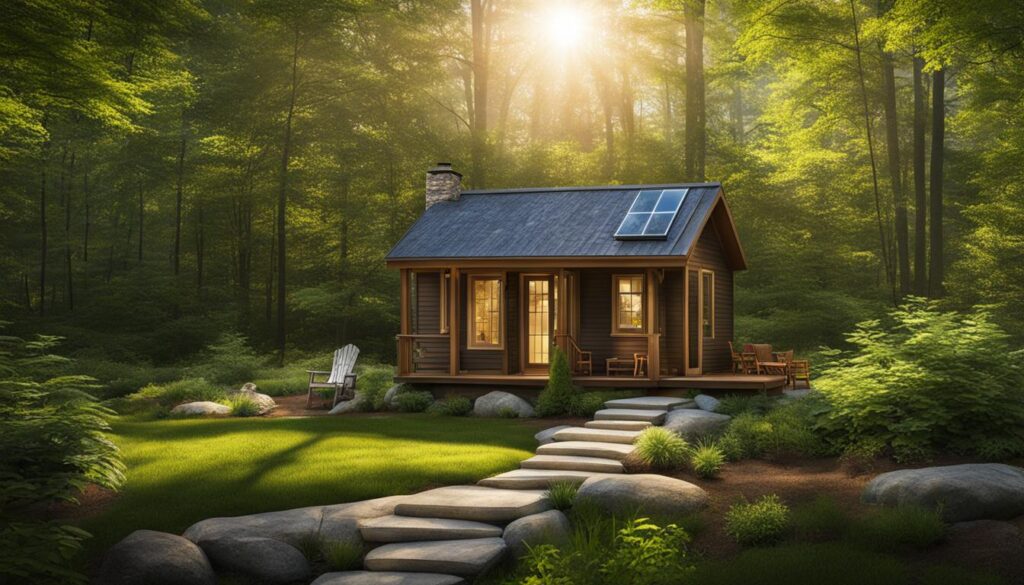
Living in a tiny house in Maryland offers a unique opportunity to experience a simpler, economical, and environmentally-friendly lifestyle. By navigating the local regulations, finding the right county or community, and organizing your tiny house to meet the necessary standards, you can enjoy the benefits of tiny house living in the beautiful state of Maryland.
Advantages and Considerations for Maryland Tiny House Living
Living in a tiny house in Maryland offers numerous advantages. One of the primary benefits is affordability. Tiny houses have lower construction and maintenance costs compared to traditional homes, making them a more accessible housing option for many individuals and families.
Another advantage of tiny house living in Maryland is the minimal environmental impact. These small dwellings require fewer resources to build and operate, resulting in reduced energy consumption and carbon footprint. By living in a tiny house, you can contribute to sustainability efforts and promote a greener lifestyle.
Additionally, tiny house living in Maryland offers a chance to embrace a simpler and more minimalist lifestyle. With a smaller living space, you are encouraged to downsize your belongings and prioritize what truly matters to you. This can lead to less clutter, reduced stress, and a greater focus on experiences and relationships.
However, it’s essential to consider a few key factors before committing to tiny house living in Maryland. Square footage requirements vary across counties, so ensure that your tiny house meets the minimum size limitations set by local regulations. It’s also important to consider utility connections, such as access to water, electricity, and waste management systems.
Parking is another crucial consideration. Before moving into a tiny house in Maryland, determine where you will park your dwelling. Explore options such as RV parks, private properties, or tiny house communities that welcome these unique homes. Ensure that you comply with relevant parking regulations to prevent any legal issues or inconveniences.
Living in a tiny house in Maryland provides affordability, minimal environmental impact, and a simpler lifestyle. However, it’s crucial to consider square footage requirements, utility connections, and parking when planning to embark on tiny house living in Maryland.
By carefully considering these advantages and considerations, you can make an informed decision about whether living in a tiny house in Maryland is the right choice for you. Remember to research and understand the specific regulations in your county to ensure a smooth and legal transition to tiny house living.
Conclusion
Building and living in a tiny house in Maryland involves navigating specific regulations and considerations. To ensure a smooth process, it is crucial to understand Maryland’s tiny house regulations and guidelines, which vary from county to county. Researching and familiarizing yourself with zoning laws, building codes, and property rules will help you make informed decisions throughout your tiny house journey.
Once you are well-versed in the regulations, it’s essential to explore suitable counties that are more receptive to tiny house living. For example, Montgomery County offers ordinances that permit tiny houses and linked units, while Garrett County is known for its relaxed laws and a greater emphasis on off-grid living.
In addition to finding the right location, it is crucial to connect with the tiny house community in Maryland. This connection provides valuable insights, advice, and support from like-minded individuals who share the same passion for tiny house living. You can find helpful resources, such as the Maryland Consumer Advisory on Insuring Your Tiny House to ensure you are adequately protected.
By educating yourself about Maryland’s tiny house regulations, exploring suitable counties, and connecting with the tiny house community, you can find your ideal spot in Maryland to build and enjoy the benefits of tiny house living. Whether you choose to live in a tiny house as a permanent residence or an environmentally-friendly vacation home, Maryland offers opportunities and possibilities for those seeking a simpler, more sustainable way of life.

